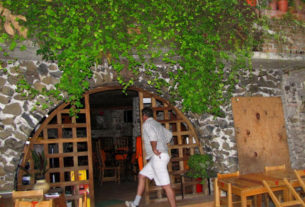The Mexico City airport is the gateway to Mexico City and Central Mexico. The Mexico City airport is also the airline hub for the entire country. If you are flying to a destination in Mexico not served by direct flights from the USA, you will probably change planes in Mexico City. More than 20 million passengers per year pass through this major airport, making it the busiest in Latin America.

The airport is 13 kilometers (8 miles) east of the center of Mexico City. The airport abbreviation is MEX, and the official name is the Benito Juarez International Airport. The airport is served by dozens of international airlines, while Aeromexico is the major Mexican airline.
Terminal One and Terminal Two
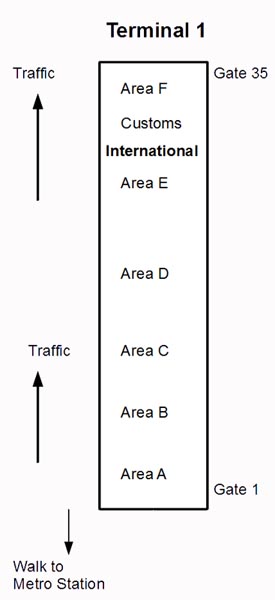
Terminal One is basically long and narrow, as you can see in the map. The public terminal is open to all. The hall with the gates is reached by taking escalators up to the security X-ray machines, and is also long and narrow.
Terminal Two is new, dating from 2007. It has two levels and is somewhat smaller that Terminal One, with only two concourses. Some airlines go to Terminal One, some airlines go to Terminal Two.
The two terminals are more than a mile apart, on different sides of the airport, without sidewalks, so it is impractical to walk between the terminals.
There is a monorail (Aerotren) that goes from Terminal One to Terminal Two. You will need to show your boarding pass to get on. Even if you have just arrived, they will accept your boarding pass. There is no charge. The Aerotren is reached above Puerta (door) 6, Area D, in Terminal One, and from the upper level in Terminal Two.
Arriving from outside Mexico
As in almost any international airport, you first go through immigration, then you pick up your luggage and go through customs. There is one form to fill out for immigration, which is per person, and another form to fill out for customs (<I>aduana</I>), which is one per household.
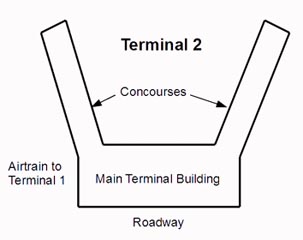
Customs uses a “red light, green light” random customs inspection system. You push the button, and the machine gives you a green light, which means you could keep walking, or a red light, which meant that your bags would be searched. The goal is to take the human element out of determining who is searched.
After you get through customs, you walk out into the main terminal. Frequently, there is a big crowd waiting for people outside the customs area. It is a good practice to stow your passport and organize yourself before leaving the customs area. You will have to leave your luggage cart (Terminal One) in customs, but there are uniformed skycaps with two-wheel dollies if you need help.
When you go out into Terminal One, turn left. In Terminal Two you just walk into the main terminal.
Shops, Money, Information, and Hotels
Like most large airports, almost anything that you might need can be found in the terminal. Snacks, souvenirs, and magazines can be found all over. There are also several sit-down restaurants, both in the public terminal and the secure gate area. The Educal bookstore, a good source of books about Mexico, is found in Terminal One near Puerta 5, near area D. This is a very good bookstore, but most of the books are in Spanish. The international departures hall has an amazing group of duty free shops, but you should carefully compare prices to those at home.
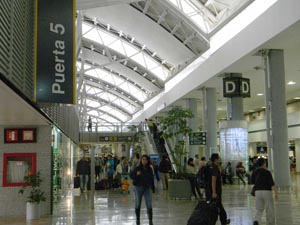
The airport has dozens of money exchange booths (Casas de Cambio), in the public terminal and the secure gate area. The exchange rates at Mexico City airport are usually very competitive, much better than at US airports, and the exchange houses seem to be always open.
There are also several ATMs in the airport. Sometimes I have had to try several ATMs, and more than one card, before I got any cash. I suggest carrying both some cash and an ATM card.
The Mexico City tourist office is found in area B. This is a good place to go if you need a hotel room. There are also information booths in the airport, but the attendants may not speak much English.
The Hilton hotel is located above the International section of Terminal One, near Puerta 7. The Marriott is reached by an overhead walkway from the bus waiting area, near Puerta 7 of Terminal One. However, both of these hotels usually charge around $200 USD per night.
Less expensive hotels can be reached by taxi or shuttle. The cheapest nearby hotel is the Hotel Aeropuerto, around $25 USD per night, which can be reached from Terminal One by walking past the metro station and taking the overhead walkway to the other side of the road. I have not stayed there, but I have heard mixed reports.
The JR Plaza and the Aeropuerto Plaza are located near the Hotel Aeropuerto, on Boulevard Aeropuerto. The JR Plaza and the Holiday Inn have free airport shuttles, and charge around $100 USD per night.
The Wings restaurant, between the JR Plaza and the Aeropuerto Plaza, is less expensive than the hotel restaurants.
I can report on the Marriott and the JR Plaza, both good hotels. I prefer the JR Plaza, but the Marriott is newer and fancier. The airport hotels are more expensive than hotels in town, and far from the tourist attractions, so it only makes sense to stay there if you are in transit and have an early or late flight.
Buses
From the small bus station at the airport, buses leave for Cuernavaca, Pachuca, Puebla, Queretero, and Toluca. Each destination is served by a different bus line.
There are escalators and a ramp leading upstairs to the bus waiting area across from Puerta 7 in Terminal One. These buses leave the airport about every hour, with the first bus around 7 a.m. and the last bus around 10 p.m. There are somewhat fewer buses to Pachuca. There is a booth that sells bus tickets, with reserved seats. This is great if your final destination is one of these cities.
If you are not going to one of these cities, I suggest you take a taxi to the appropriate major bus station in Mexico City. The airport buses are more expensive than most buses in Mexico, and you can probably go directly to your final destination from one of the major bus stations. Mexico City has four major bus stations, for the four cardinal directions.
Metrobus
Metrobus is a relatively new service, using dedicated bus lanes from the airport into the downtown district.
Line 4 is the line that goes from the airport to downtown. Line 4 has a north and a south route, which run north and south of the zócolo, so study a map to choose which route will work best for you.
Depending on the location of your hotel and your luggage, you may not need a taxi at all. Look for a machine selling metrobus cards, as the bus does not accept cash, and you need to buy your card before you board the bus. The buses reportedly run every 20 minutes, with the cost of 30 pesos to and from the airport, less than $3 USD.
The Metrobus can be boarded between Puerta 6 and 7 in Terminal One, and Puerta 3, lower level, in Terminal Two. I judge this service to be significantly safer than the metro, and the price is right.
Rental Cars
There are more than ten auto rental agencies located at the Mexico City airport, generally the major brands from the USA such as Hertz, Avis, etc. There are booths in the airport, with shuttle buses to take you to your car.
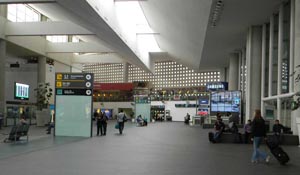
As in most big cities, a car is more of a liability than an asset. Rental cars in Mexico are always expensive. If you do rent a car, be sure to buy the Mexican insurance. I do not recommend driving in Mexico City for the faint of heart. I only drive in Mexico City every ten years or so, because it takes me that long to forget how hard it was last time. If you do decide to pick up a rental car in Mexico City, you will need to buy a good map of the city, probably the Guia Roja, and you will need an excellent navigator. A GPS with Mexico maps is another option. Alternately, you could hire a taxi to guide you to the edge of the city, or to your destination.
Taxis
Taxis are an important and complicated subject. Because of the problems of taxi robberies, you should never take random passing taxis anywhere in Mexico City.
Official taxi stands, (sitio) with a person with a clipboard logging each departure, are regarded as safe by most experts.
If it is just a line of taxis, there is no control, and someone with a stolen or bootleg taxi could rob you, usually with the help of his confederates. The pirate taxis may not have license plates. Also, look for the sticker on the windshield that shows the name of the taxi stand or sitio.
A hotel can call you a radio or hotel taxi, and get the description of the taxi and its number. However, the radio or hotel taxis are the most expensive.
Some people hire a radio or hotel taxi for a day of tourism; this is probably the safest and most convenient option, but a bit pricy.
I understand that tipping taxi drivers is not required. I suggest that you agree on a price before getting into the taxi, unless the driver is going to use a taxi meter, or you have bought a prepaid ticket. Generally it is cheaper to use the taxi meter; ask “Hay taximetro?”
The Secret Taxi Stand with the Cheap Taxis:
The least expensive taxis at the Mexico City airport are more or less hidden, on the other side of the highway that goes by Terminal One, with no signs in the airport telling you where they are.
In Terminal One, near Puerta 5, take the escalator as if you were going to catch the aerotrain. Instead of turning right towards the aerotrain, continue a short distance, and take the stair that leads down to the left.
This taxi stand is Base Concord, tel. 5762-0756. You will need to haul your luggage down the stairs.
Airport Taxis
The official airport taxis have the image of an airplane on the side. They are found at the taxi stand near Puerta 1 and Puerta 7 in Terminal One, as well as near Puerta 4 in Terminal Two.
There are several taxi companies competing for your business. You go to the taxi ticket window and tell the ticket agent where you are going. She will sell you a ticket, which you take to the tourist taxi stand outside. These taxis are typically small sedans, adequate for three people with moderate luggage. The airport taxis cost half again as much as regular taxis cost. A typical fare, depending on the distance, is probably $15 to $20 USD, or 150 to 200 pesos.
If you have more than three people, there is another option. The same taxi ticket office and taxi stand offers Suburbans, as a kind of executive transportation. Suburbans cost almost double what a tourist taxi costs, but are good for a group of four to eight people, or if you have an unusually large amount of luggage.
Miscellaneous
There is a locker service at the end of area A, Terminal One. There is a similar service in Terminal Two.
Mexico City has serious crime issues, and the airport is not exempt. Corruption among employees and officials is not unknown. Be security conscious while you are at the airport, or anywhere in Mexico City. For more information on security issues in Mexico City, review the US State Department travel warnings at
There is a Metro stop two minutes’ walk from Area A, Terminal one. However, crime is a problem, and I do not recommend traveling on the Metro with luggage or valuables. The subway costs less than $0.25 US.
Unlike many cities, the airport does not have an airport limousine or bus service. Take a taxi instead.
The public phones at the airport, as in most of Mexico, require a prepaid phone card, available in shops for 30 or 50 pesos.
The airport has a web site with more information, www.aeropuertosmexico.com.
Departure
When you arrive at the curbside of the airport, you will find many uniformed skycaps with two-wheel carts or dollies wanting to take your bags. A polite “No, gracias” will generally suffice to have them leave you alone.
In Terminal One, you should check in with the airline at the counter on the main (lower) level, and then take the escalators upstairs to security. The departure gates (Salas) are clearly marked, and there are the usual airport flight status monitors. In Terminal Two, the airline counters are on the upper level.
The departure tax is included in your airline ticket
Enjoy your trip to Mexico City, or wherever your final destination is in Mexico.
Richard Ferguson
February 8, 2002, November 2007, July 2012
The information in this article was based on many trips through the Mexico City airport, most recently in 2012. The exchange rate used in this article is 13 pesos to a US dollar.

